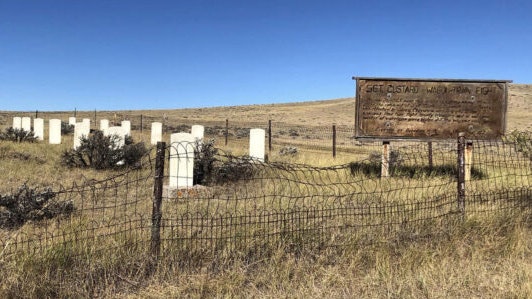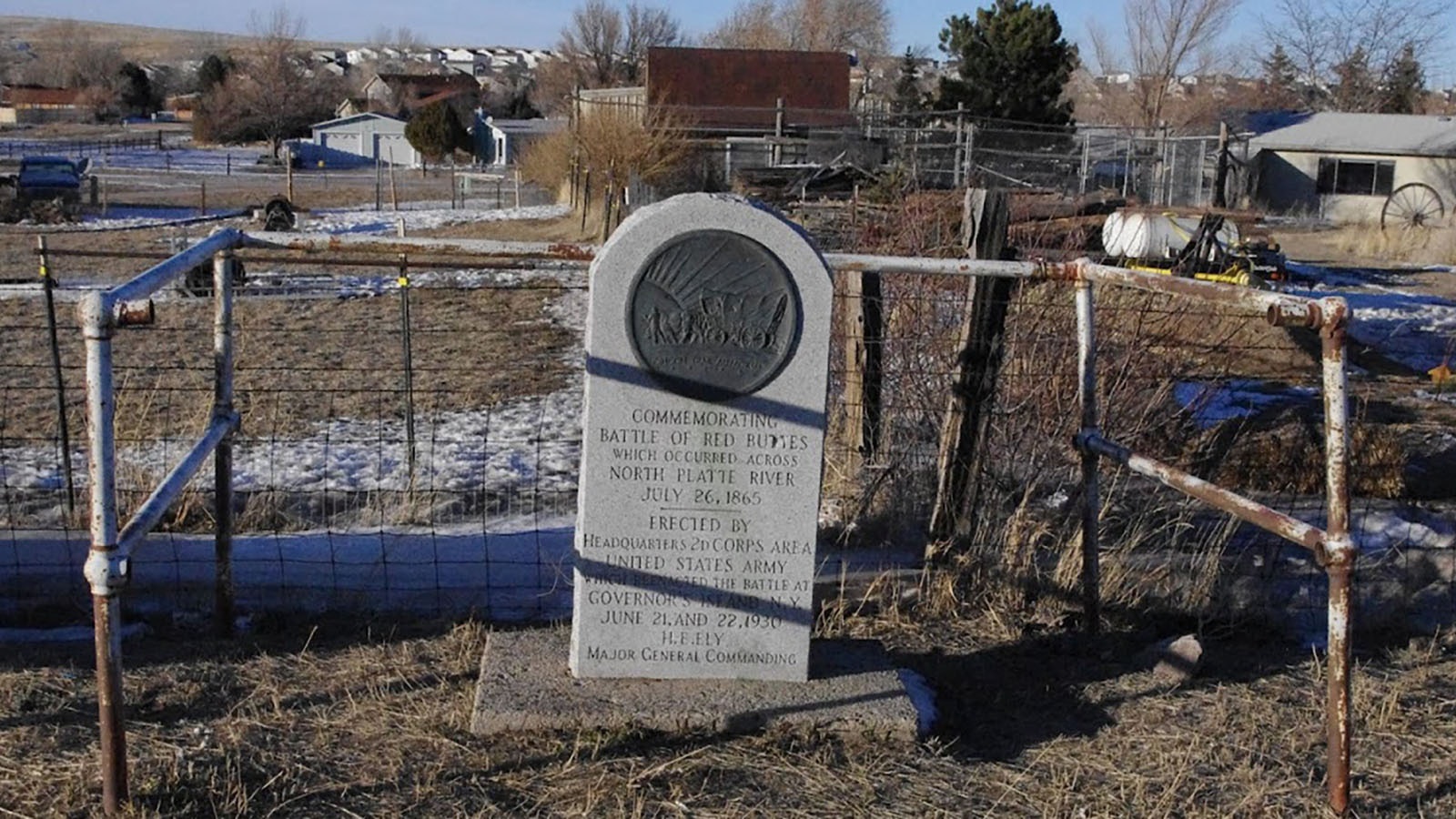A battle fought in 1865 near modern-day Casper between American Indians and U.S. Cavalry soldiers led by a man named Custard helped set the stage for the famous Battle of Little Bighorn in Montana, the last stand of a man named Custer.
Everyone knows about the Battle of Little Bighorn. It’s often called “Custer’s Land Stand” because Lt. Col. George Armstrong Custer, commander of the 7th Cavalry Regiment, was among the 286 U.S. soldiers killed while fighting warriors from the Lakota Sioux, Northern Cheyenne and Arapaho tribes.
However, most people are probably unaware of another battle between the same tribes and the U.S. Army that happened a decade earlier and contributed to a growing atmosphere of hostility that boiled over at Little Bighorn. That was “Custard’s Last Stand,” the Battle of Red Buttes, fought a few miles outside Casper in 1865.
What was Custard’s Last Stand, and how did it contribute to Custer’s Last Stand a decade later?
Custard’s Last Stand
In the summer of 1865, the American Civil War was reaching its end in the Eastern United States. But another war was beginning in the American West.
The brutal path that led to the Battle of Red Buttes started the previous winter with the Sand Creek Massacre in southeastern Colorado. On Nov. 28, 1864, Col. John Chivington and 675 soldiers in the 3rd Colorado Cavalry descended on a Cheyenne and Arapaho village and killed at least 135 people, mostly women and children.
“The massacre united the Lakota, Cheyenne and Arapaho to get revenge for what had happened,” said Rick Young, manager of the Fort Caspar Museum in Casper.
Emotions were still high in the summer of 1865. Soldiers and settlers were attacked and killed by warriors from all three tribes at several locations across Wyoming and Colorado.
On the morning of July 26, 1865, Commissary Sgt. Amos Custard of the 11th Kansas Volunteer Cavalry was headed east toward what was then known as the Platte Bridge Station. This was a military fortification on the Platte River now within the city limits of Casper. Custard commanded 22 men returning from a mission to resupply U.S. Army forts further west.
A soldier from Platte Bridge Station, 20-year-old 2nd Lt. Caspar W. Collins of Ohio, was ordered to meet Custard and the supply wagons. Soon after Collins left the fort that morning with 25 men of the 11th Kansas, they were attacked by as many as 1,000 Cheyenne, Lakota and Arapaho warriors.
Collins and five other soldiers were killed in what would become known as the Battle of Platte Bridge. The survivors retreated to the fort while Sgt. Custard and his wagons continued their approach.
“Later that day, the wagons show up on the horizon,” Young said. “The army fires a cannon (from the fort) to warn them of all the (warriors) in the area. The tribes see the wagons as well, and they ride out to confront and attack them.”
Custard circled the wagons, and the 11th Kansas Volunteer Cavalry made a stand. After several chaotic attacks and failed attempts to make a better defense, all 22 men with the wagons were killed, including Custard. Only three men escaped and reached safety at Platte Bridge Station.
By the end of the day, 29 U.S. soldiers and at least eight Native American warriors were killed in the Battles of Platte Bridge and Red Buttes.
Lost To The Prairie
While many of the facts of the two battles are well documented, many mysteries remain nearly 160 years later. For instance, the exact location of the battles has yet to be fully determined.
The Battle of Platte Bridge was “a running fight,” so the battlefield stretched over a mile. That expanse has since become the town of Mills.
Meanwhile, the exact location of the Red Buttes battlefield has been a mystery since shortly after the battle.
“Nobody has been able to mark an ‘X’ on the ground for the Red Buttes battlefield,” Young said. “The memorial stones that you see are probably a half to three-quarters of a mile north of where the battle took place.”
What makes the mystery of the Red Buttes battlefield more intriguing is that all 22 soldiers who died during the engagement were buried at the site. Soldiers from the Platte Bridge Station buried the dead in two trenches the day after the battle, but the location wasn’t permanently marked or documented.
“The interest locally is that the guys were buried on site, and then the battlefield and the graves were lost to the prairie,” Young said. “Since they never found where the bodies are, the memorial stones in Red Butte Cemetery represent the soldiers that were buried there. But they’re not there.”
Red Butte Memorial Cemetery is the closest thing to a battlefield marker, despite the disparity in its location. It sits on Bureau of Land Management land at the western end of Trevette Lane in Casper.
Some bodies were recovered “west of Fort Caspar” and moved south to Fort Russell, now F.E. Warren Air Force Base in Cheyenne, in 1899. They were buried as soldiers from the 11th Kansas Cavalry, but that identification is dubious.
“Their headstones are marked ‘Unknown 11th Kansas Solider,’ but we don’t know how they identified them and determined they were 11th Kansas,” Young said. “If they really are, it has to be some of the guys from Red Buttes. But it’s not enough of them. And there’s a lot ‘west of Fort Caspar.’”
Even the soldiers who originally buried the bodies on the battlefield couldn’t precisely recall where the graves were.
“They brought soldiers back in the 1920s. By this time, they were fairly elderly and had a hard time recognizing the location. They couldn’t definitively identify the spot,” he said.
Finding The Fight
Previous archaeological surveys looking for the Red Buttes battlefield found nothing conclusive. However, a recent land swamp with the Bureau of Land Management might lead to the definitive discovery of the site.
The newly acquired property is roughly 4.5 miles from Fort Caspar. Eyewitnesses said they could see the Battle of Red Buttes happening 4 and 5 miles from the fort.
The Natrona County Historic Preservation Commission and BLM archaeologists plan to survey the location soon and look for the telltale signs of battle.
“I’m pretty sure we’re in the right neighborhood,” Young said. “We need to find a mix of the projectiles used and the wagons. If you find and orient those wagons and there’s a number of bullets around them, I think that pins it down. Something like that would seal it up, and we could mark an X on the ground and say this was the location of the Red Buttes fight."
And the graves?
“Unless we pull up skeletons, we’ll just not know,” he said.
Buildup To Little Bighorn
The aftermath of the Battle of Red Buttes saw an increase in the militarization of the West. As the American Civil War ended that summer, thousands of soldiers were moved to garrison forts across the American West.
The scale of the Battles of Platte Bridge and Red Buttes convinced the U.S. Army to adopt a more aggressive strategy against the tribes. More than 2,000 U.S. soldiers started pushing through Wyoming and Montana in the Powder River Campaign in late July 1865, establishing new forts and the short-lived Bozeman Trail.
The alliance of the Cheyenne, Lakota and Arapaho would continue into the next decade. The same tribes, and likely many of the same warriors who fought at Red Buttes, defeated George Armstrong Custer and the U.S. 7th Cavalry at Little Bighorn in southeastern Montana in 1876.
Then there’s Lt. Caspar Collins. After he was killed in the Battle of Platte Bridge, the Platte Bridge Station was renamed Fort Caspar in his honor. While Fort Caspar was abandoned in 1867, it inspired the name of the city of Casper (swapping the ‘a’ for an ‘e’), incorporated in 1887.
“Custard’s Last Stand” is a small but important part of Western and Wyoming history. For Young, finding and preserving the Red Buttes battlefield would honor the unique ripples of history and show how one engagement between the U.S. Army and the Lakota, Cheyenne and Arapaho leaves a lasting mark today.
“It was an important historical moment in our area’s history," he said. "Being able to locate the site allows you to preserve it. It’s worth preserving. For me, it would be important to preserve it for future generations."
Andrew Rossi can be reached at arossi@cowboystatedaily.com.








